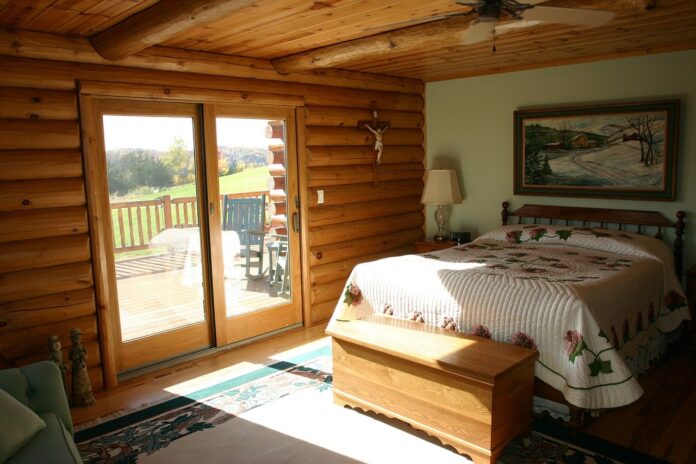Log cabin homes that were built for centuries are still quite common choice of people planning to build such mobile homes in many countries, but the popularity of massive log houses has significantly decreased with the advent of glued beam houses a little over 50 years ago. The change was due to the fact that glued beam mobile homes, which retained all the good features of log cabin homes, did not have the main disadvantages, such as cracking, sitting or twisting of logs, typical of solid wood houses.
The same reasons encourage glued timber beam houses to choose today. Glulam houses are now especially popular in Finland, Japan, Australia, Switzerland, Scandinavia, France, Spain and Germany, and the popularity of such houses is growing every year. However, before deciding whether a glued beam mobile homes could be a choice that meets your expectations, we asked Maestro Cabin experts to take a closer look at the advantages and disadvantages of such houses.
Features of glued beam mobile homes
The production process of glued beam houses is little different from the production of massive log cabin homes. Untreated logs are cut into oblong boards by special machines and dried very well in a dryer, and then, after stripping, they are joined with a hydraulic press using a special, water-resistant glue. Although glued and laminated logs are very similar to those used for solid wood houses, due to their different treatment they have a number of unique features that create a significant advantage when choosing wood for mobile home construction.
Advantages of glued beam mobile homes
Probably the main requirement we make when choosing any type of log cabin house is strength and durability. It is these qualities that we can first distinguish when talking about glued beam houses. Although their production technology is relatively new, research shows that this type of house is even stronger than solid wood. This advantage is due to the fact that the core on the boards allows to remove any stress of the wood and increases the strength and stability. An alternative to these is glued plywood, which is not sensitive to changes in ambient temperature and humidity because it is particularly dry. For this reason, glued beam houses “sit” up to 10 times less than other solid log cabin homes, and the wood does not crack, thus preserving its texture, smell and other unique properties.
Another important practical property of wood is excellent heat and sound insulation. It is no secret that log cabin homes have been built in cold climates for centuries, given that wood retains heat much better inside a log cabin home than conventional building materials. However, even among log cabin homes, a particularly high level of thermal insulation is distinguished by glued beam wooden houses – their walls are placed on top of each other without leaving even the slightest gaps, which often occur in log cabin homes.
Last but not least, the use of modern woodworking machines creates high-quality cutting angles that retain the wind and prevent heat from leaving log cabin home. In this case, gaps appear in the walls of massive log cabin homes in the long run, which let off both wind and heat. Glued beam houses only increase the insulation precision automatic cutting machines cut even the smallest gaps during construction. The structure of glued wood is practically no different from brick, so, having done all the work professionally, you will have thinner partitions in the house with significantly better thermal and sound insulation parameters than a brick wall of similar thickness.
When assessing the practicality of glued beam houses, it is necessary to emphasize the high surface quality characteristic of glued wood. The latter is extracted due to the possibility of cutting branches in the beams and removing other possible wood defects. With the help of hydraulic presses, which prepare the walls, the walls become completely smooth, do not puncture, and do not infest pests. Because log cabins have an antistatic charge, they do not form dust balls, which are most common in masonry construction.
Glulam houses do not require additional interior or exterior finishes, as they already look attractive in themselves, so if you give priority to natural wood, you will save on the necessary work. Due to natural building materials, glued beam houses “breathe” particularly well, so they do not create a need for a conditioning system. Optimal indoor temperature in winter will ensure excellent thermal insulation, and in summer inside the house for the same reason will be pleasantly cool.
Disadvantages of glued beam mobile homes
Although, as mentioned earlier, glued beam houses sit insignificantly, they still sit, so this should be assessed not only in the selected finishing work, but also in anticipating the additional costs in the future that will be required to address the consequences of this process. If you decide that your glued beam house needs extra finishing, despite the high quality of the wood, you will need to renovate it by repainting the house at least every 8 to 12 years. A little more inconvenience than a faded log cabin home wood color or a slightly dilapidated house wall may necessitate at least a slight change in the layout of the house, so we suggest assessing the needs of yourself and other family members particularly well before starting construction. However, with the idea of renovating the spaces of the house, this process can be significantly complicated by the limited distance between the spans of the house.
It is also important to mention that glued beam houses should be purchased only from reliable suppliers. It is not uncommon for producers who, in an effort to save money in the production of a house, add a certain amount of low-quality wood, which then blackens or bounces off the beam, thus causing quite a few additional problems.
Although glued beam houses have an optimal price-quality ratio, the price of such a house is mainly determined by the type of wood and the size of the house under construction. Probably the most popular and the most economical wood variant for such buildings is Siberian spruce, pine or larch wood. The average price of a house made of these materials could range from 150 to 200 euros per m2. When choosing high-quality wood, its excellent insulation will retain heat for much longer than the economical material option, and will therefore also reduce heat costs during the cold season. The choice of high-quality wood will also lead to the fact that the glued beam house will not need additional interior or exterior finishing, thus saving a lot of money for essential work.
To read more about log cabin homes and mobile homes visit maestrocabins.co.uk







